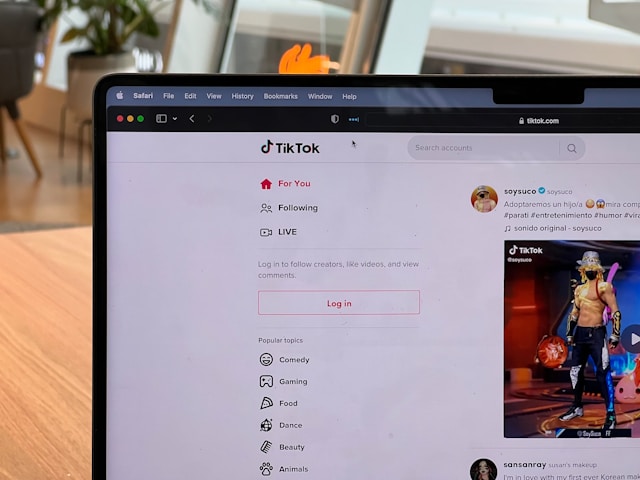TikTok Business Model: How Does It Work?
Since its launch, TikTok has gathered over a billion users, allowing them to share different types of video content. This app plays a major part in the social media landscape. But do you ever wonder how the TikTok business model generates revenue for the platform?
Unlike traditional social media apps, TikTok has a unique algorithm that pushes personalized content, keeping users engaged for longer periods. This engagement forms the base of its business model since it allows for advertising, partnerships, and sales.
Read more to learn about this model.

Understanding the TikTok Business Model
TikTok, a popular social media platform, allows users to create and share short-form videos. A Chinese company, ByteDance, created this app in 2016 and launched it a year later. The app quickly gained popularity globally and attracted users of all ages.
TikTok’s business model is a bit peculiar, but like any other social media platform, it thrives on user-generated content. The app has features that encourage creativity among users. These include filters, soundtracks, and effects that support different tasks.
The platform also provides several editing tools that allow users to tweak and personalize their content. Unlike other apps, where professionals and brands exclusively create content, anyone can make content for TikTok.
The TikTok algorithm plays an important role in its business model. This algorithm factors in users’ behavior, preferences, and past interactions to recommend content they’d want to see. While this improves the user experience, it also provides insights for marketers and advertisers to reach their target audience.
The social platform also collaborates with celebrities, influencers, and brands to create sponsored content. This way, it can promote certain services and products by tapping into the influencers’ and celebrities’ existing audience.
The TikTok business model depends heavily on revenue from advertising. Since the platform is attracting more users and becoming more popular, brands are more willing to advertise here. Hence, the social media app offers several advertising options, including branded hashtags, in-feed ads, and branded effects.
These allow businesses to create campaigns that fit their goals and help them reach their target audiences better. TikTok also runs e-commerce services, allowing users to shop on the app directly. This is another revenue stream. Overall, the app business aspect revolves around helping brands reach their audiences.

How Does TikTok Generate Revenue Through Advertising?
TikTok offers several advertising options for brands and businesses to promote their products and services for a fee. The social media platform generates most of its revenue through this method. These ad options include in-feed ads, branded effects, and branded hashtags.
Since the platform has a large and engaged community of users, it is quite effective for reaching younger people. Ads also allow brands to promote their products and services engagingly. Here are the types of ads available on the social media app.
1. In-Feed Ads
These are video advertisements that seamlessly integrate into TikTok users’ news feeds, blending with organic content. In-feed ads look, feel, and interact like regular organic videos. They autoplay with audio and are usually five to 30 seconds long.
Viewers can engage with in-feed ads on TikTok by liking, commenting, sharing, or following the added call-to-action on the ad landing page. TikTok has made these ads less disruptive by allowing them to be as organic as possible. It is one of the company’s largest revenue sources.
2. Brand Takeover Ads
Brand takeover ads appear as soon as a user opens the TikTok app. These high-impact ads remain on the screen for some seconds before making way for your feed. They help to boost brand recognition and push instant messages.
Brand takeovers are usually three to five seconds long and consist of pictures, GIFs, or videos. TikTok charges more for these ads since it only offers a few spots daily. The ads may also contain clickable links that redirect viewers to a landing page.
3. Top View Ads
These ads appear after a user has scrolled down their feed for some time. They are attention-grabbing ads that offer brands up to 60 seconds of full-screen videos. Unlike brand takeover ads, they auto-play with sound and blend into organic videos.
While TikTok has made them less intrusive, they still provide high visibility. Viewers can like, comment, and share these ads. They can also follow the clickable links that direct them to the advertiser’s website or landing page. TikTok charges brands based on the ads’ reach, duration, and user engagement.
4. Branded Hashtag Ads
TikTok turns popular challenges and trends into a revenue stream with branded hashtag ads. Brands create these challenges under specific hashtags and invite users to participate in them. As a result, there is a lot of user-generated content and community engagement. These ads appear on the platform’s Discover page and run for days.
TikTok makes money from these challenges by charging a fixed fee for branded hashtag ads. Extra revenue comes from in-feed and top-view ads that support the branded hashtag. Since these ads drive engagement and brand visibility, many businesses opt for them.
5. Branded Effect Ads
With TikTok’s branded effects feature, users can create custom and interactive effects like stickers, filters, and augmented reality. They can then add these effects to their effects tray, creating content with them and maximizing engagement.
Branded effects‘ immersive nature increases visibility and allows other users to interact with the branded effects directly. TikTok charges fixed fees for creating and promoting branded effects. Since businesses usually combine these effects with branded hashtags to increase their exposure, the platform enjoys more revenue.

How Does TikTok Make Money Without Ads?
Besides advertising, TikTok generates revenue from in-app purchases, virtual gifts, and partnerships. As one of the fastest-growing social media apps, the app has effectively used its massive usage to an advantage.
However, these revenue sources are not independent of the app itself. Yet, they are quite helpful for stabilizing the platform’s earnings. Here are the ways TikTok makes money without ads.
1. In-App Purchases
TikTok generates most of its revenue from in-app purchases. Here, users can buy virtual coins, which they can use to purchase virtual gifts to send to their favorite creators. This creates a sense of community among creators and their viewers and is an extra revenue stream for the platform.
TikTok’s in-app purchases have essentially created a dynamic economy on the app. Users can purchase virtual coins in different amounts and denominations. They can then purchase gifts like stickers, emojis, and other virtual items, which they’ll send to creators during live streams.
These digital gifts have become more popular over time, boosting TikTok’s revenue generation. Recently, more users have been willing to spend money to support their favorite content creators on the app. While these creators make money on TikTok live streams, the app also makes money.
TikTok has also launched another virtual currency, the diamonds. The app allows users to get exclusive and premium gifts with them. Still, TikTok charges a fee when creators convert their coins to diamonds and convert them to real money.
The social media company benefits from in-app purchases by retaining a percentage of the funds when users transact. This allows content creators to earn on the platform and TikTok profits from the activity yearly.
2. E-Commerce Offerings
TikTok allows brands and businesses to sell products and services directly within the app. The TikTok shop and the platform’s shoppable ads form major revenue streams for the company.
With these features, businesses can create a smooth shopping experience for customers. Users can view and purchase products directly without leaving the social media app. Since TikTok takes commissions for every sale, it earns substantial revenue.
The TikTok shop, for instance, helps brands that may not have established physical locations sell their products. However, large companies also use this feature due to the platform’s massive user base.
Through this shop, brands can promote and sell products directly. Here, brands can reach customers using live streams or short videos with integrated product links. Any brand can create and generate content to promote its products this way.
On the other hand, brands can sell their products on TikTok’s shop through the platform’s affiliate program. This involves working with influencers to build promotional campaigns to push products to a wider audience.
TikTok charges up to 3.78% for orders, with a shopping fee included. The TikTok shop also charges a commission fee that typically falls between 2% and 8%. Still, the exact fee depends on the product category and sales volume. These fees contribute majorly to the app’s revenue.
3. Partnerships and Sponsorships
Exposure and brand awareness are valuable in many industries, especially entertainment. So, TikTok offers sponsorships and collaborations with brands to create specialized content and promotional campaigns.
Usually, brands partner with this social media company to leverage its massive user community and reach millions of users. Whether they create sponsored challenges or sponsored videos from creators, they target improved exposure.
TikTok generates revenue from these partnerships and sponsorships through the fees it charges brands for the campaigns. The company charges varying amounts for its strategic and high-visibility placements. It also earns from connecting brands with popular creators and different types of influencers.
In addition to partnerships and sponsorships, most campaigns include ongoing spending on ads within the platform. This further boosts the platform’s revenue. Most of the platform’s revenue streams are interconnected, as you’d expect. If brands opt for one strategy, they may need support from another.

Limitations of TikTok’s Business Model
TikTok’s business model is highly successful in terms of growth and user engagement. However, it faces several limitations that can affect its sustainability. Here are several issues that may hinder its long-term success.
1. Increased Regulatory Scrutiny
Several countries, including the U.S. and India, have restricted or banned TikTok due to increased data privacy and security concerns. Increased regulatory scrutiny has affected the app’s capacity to operate and generate revenue in those regions.
2. Privacy and Data Security Concerns
TikTok has faced prolonged scrutiny, especially in the U.S. and Europe, over its handling of user data. TikTok’s ties to the Chinese government through its parent company have also sparked concerns in those regions. These governments have proposed major restrictions and data localization measures that essentially limit global operations.
3. Dependence on Advertising
Like other social media platforms, TikTok depends heavily on advertising for its revenue. This reliance on ads can be problematic due to potential drops in ad demand and regulatory changes. It may also limit its revenue, especially during periods of economic downturn when companies cut down on ad spending.
4. Limitations Due to User Demographics
The majority of TikTok users are young people, and the older demographic may not find the platform appealing. This factor often limits interest from advertisers whose target audience is older people. Since the platform’s content does not shift to cater to older people, this is a dragging issue.
5. Massive Competition
TikTok’s major competitors in the video hosting space are YouTube, Instagram, Facebook, and Snapchat. Since these other platforms continually implement innovations to keep their users engaged, TikTok often struggles to keep up.
As you may have noticed, competitors have replicated TikTok’s features in the past. This is obvious with Facebook Reels and YouTube Shorts. This reduces the app’s uniqueness since users can opt for its many alternatives.

TikTok Model’s Competitive Advantage Over Other Social Platforms
TikTok’s revenue model stands out from other platforms due to its highly engaging design that captures users’ attention with short-form content. The platform’s For You Page (FYP) or the For You Feed uses a strong recommendation algorithm that factors individual preferences.
For this reason, TikTok users enjoy an engaging feed that shows personalized content to keep them engaged. This feature makes the platform more appealing to brands looking to connect with younger audiences.
Since it offers several ad types, brands can engage with users in more interactive ways. The social media platform focuses more on content creators, integrating features that allow E-commerce.
It is also ideal to create shippable videos and promote your products through influencer marketing. The app goes beyond traditional social media ads, helping businesses promote themselves and generating revenue for itself.

The Future of TikTok’s Business Model
Since its launch, TikTok has grown quite rapidly, creating several unique video features before most of its competitors. Experts have projected that the platform’s Gross Merchandise Value (GMV) will reach $23 billion in 2024.
The platform has added the TikTok for Business feature, which allows users to display and sell their products directly. In this case, there is no need to redirect users to external landing sites. This feature offers a solid platform for businesses and the app to leverage and generate revenue.
Although the app does not appeal to all age groups, many demographics are getting more active. Hence, brands have more opportunities to reach their customers through this platform. Overall, the app continues implementing newer features that benefit brands and draw more revenue.

Grow Your TikTok Account With High Social
To use TikTok maximally for your business activities, you must grow your audience and reach as many people as possible. However, achieving organic growth may be tricky, especially if you have little experience on the platform.
If this is your case, let High Social, our TikTok growth agency, do all the work for you. This agency gets you real and organic followers based on your requirements. We focus on attracting high-quality followers who find your content interesting.
To use our service, visit the High Social website, sign up, and choose your target audience. You can specify based on age, location, and gender. Our growth service will immediately promote your content to that audience.
Subsequently, those who find your content interesting will follow your profile. You’ll end up with highly engaged and authentic followers. Combined with your knowledge of the TikTok business model, you can grow and earn on the platform.
FAQ
After discussing TikTok’s business model, let’s answer some frequently asked questions on the subject!
TikTok earns money through advertising. The social media platform offers different ad formats, such as in-feed ads, brand takeovers, branded hashtags, top-view ads, and branded effects. The platform also earns from in-app purchases, e-commerce offerings, and partnerships.
TikTok’s business strategy involves leveraging short-form, user-generated video content and a powerful recommendation algorithm. The platform then fosters a strong community through viral trends, challenges, and creative tools. It also uses targeted advertising and influencer marketing to help brands and users earn while the platform also generates revenue.
TikTok’s ads have a high success rate. More than 80% of users find the ads on the platform fun and entertaining, proving that its ads strategy has an impact on its users.














